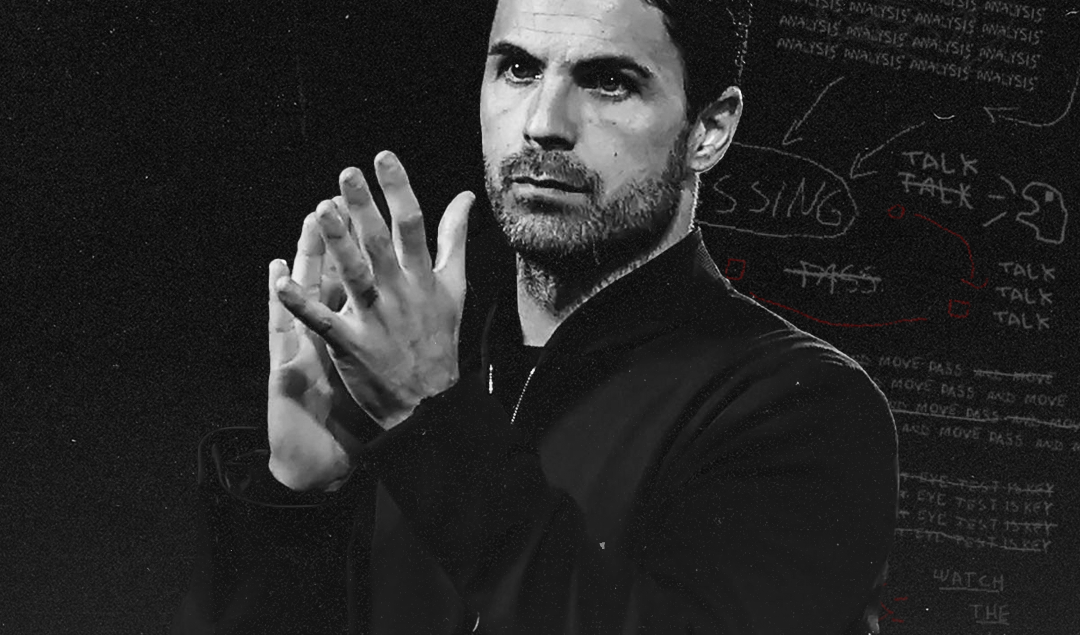The Underlying Stats Behind Arsenal’s Progress Under Mikel Arteta
The perception of Arsenal’s season has changed dramatically in the past few weeks. For much of the campaign, they were heralded for their coterie of exciting young players who had been assembled, coached, and assimilated within an astute tactical framework established by their equally compelling and youthful head coach, Mikel Arteta.
Now, as they let a top-four finish slip by in a demoralizing display at White Hart Lane and a tame defeat to Newcastle United, they’ve been lambasted for yet another season of underachievement and disappointing displays from an inconsistent and mentally brittle squad.
The Gunners undoubtedly lost out on a golden opportunity to return to Europe’s premier competition; and whether it’s in the dressing room, the transfer market, or their finances, they are bound to suffer the consequences.
That, though, should not come to define their season. Their progress under Arteta has been evident, and ought to be applauded as the first signs of genuine forward momentum for the club since Arsene Wenger retired. Arsenal’s underlying metrics make this evident.
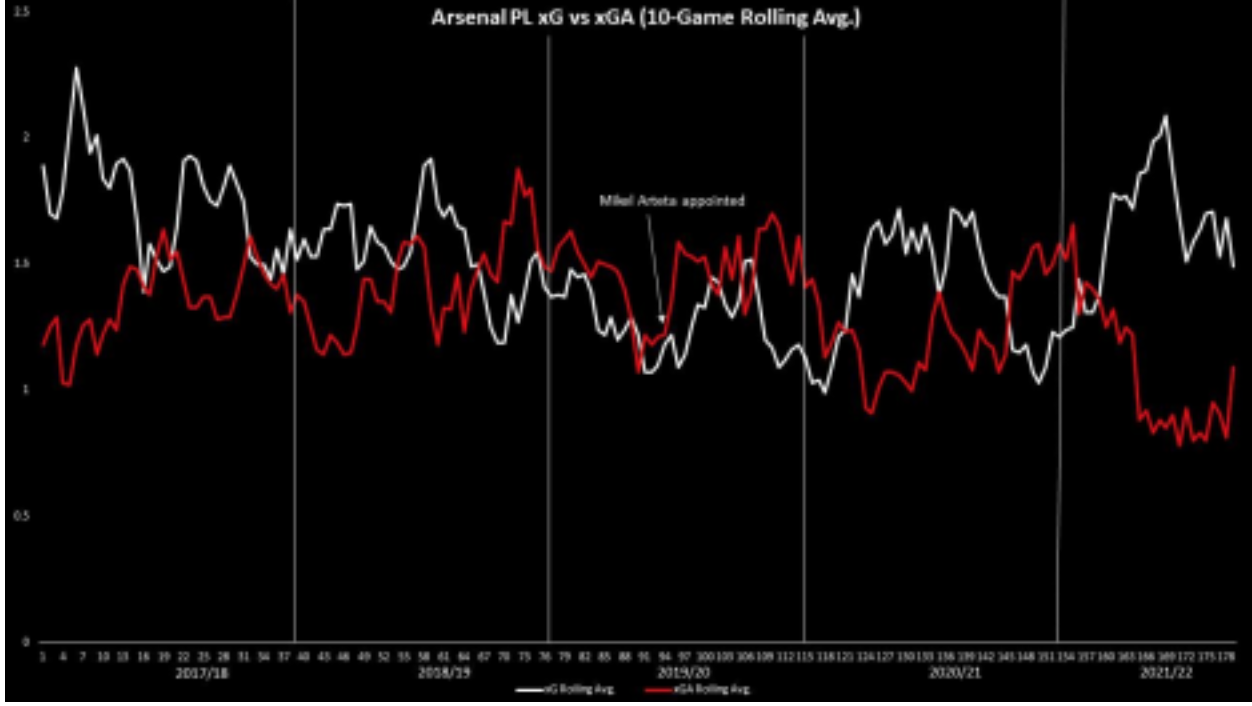
Data sourced from: FBRef. xG is expected goals, which measures the quality of a chance by calculating the likelihood each shot a team takes will be scored based on its location, phase of play, and other factors. xGA, is expected goals, measures the quality of chances a team conceded using the same process.
The above graphic displays Arsenal’s expected goals versus their expected goals against in the Premier League since the 2017/18 season.
It compares the quality of chances they created with how well they prevented the opposition from creating opportunities, providing a simple yet instructive illustration of how well the Gunners performed across various seasons.
The 2020/21 campaign saw a marked and fairly consistent improvement in Arsenal’s expected goals against, and they’ve since built upon that by further bolstering both their defensive and offensive performance.
Defensive Improvement
A few factors have coalesced to produce Arsenal’s defensive improvement. Arteta settling on a back four and a clear first-choice backline has given the team greater defensive continuity compared to last season, where system and personnel were frequently changed.
The recruitment of Takehiro Tomiyasu at right-back has also given the team a more aerially dominant and defensively reliable fullback option than Hector Bellerin and Cedric Soares in previous years.
Takehiro Tomiyasu: A Transformative Cog in Mikel Arteta’s Youth Revolution
Arteta also deserves credit for his tactical improvements to Arsenal’s defensive posture. Specifically, he’s improved the intelligence and intensity with which they press in the opposition half and given the team a solid structure which they can fall back on when the press is broken or cannot be sustained.
In previous years, Arsenal have lacked a solid defensive shape they could trust for prolonged periods of the game. Their midfield and defensive lines would be too spaced out, and when the ball was switched from one flank to the other, the Gunners would usually struggle to shift across in time and with sufficient men to smother the opposition attacks.
Due to their disjointed shape, players would often make rash decisions in an effort to cover space and men that could not be controlled by the team as a whole, further hurting Arsenal’s defensive capabilities. In their 2-1 defeat to Manchester City in January, Arsenal displayed the progression they made in the defensive phase.
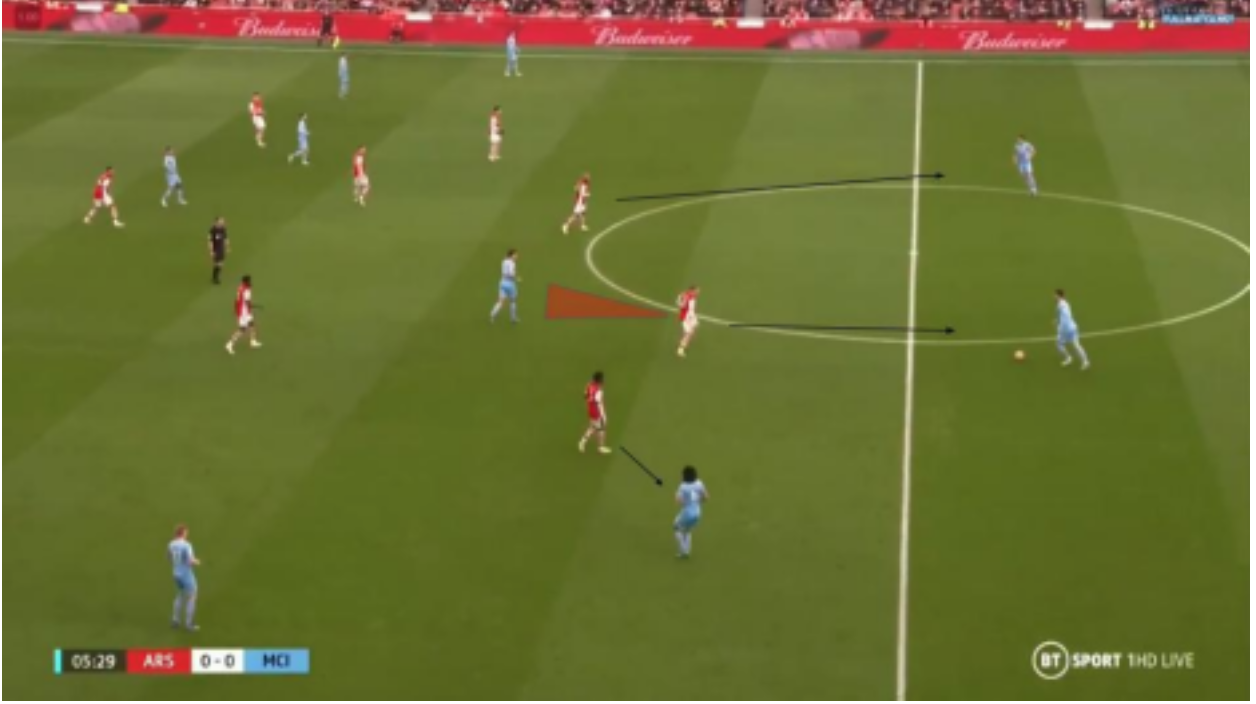
As can be seen in the above image, there is minimal space between the midfield and defensive lines, making Arsenal harder to play through and denying City players space and time in between the lines. Martin Odegaard is intelligently positioned to both apply pressure to Aymeric Laporte while also preventing the pass into Rodri with his cover shadow.
Bukayo Saka and Alexandre Lacazette are also in prime positions to apply pressure to the two City players closest to Laporte, the man on the ball. It’s also noteworthy that as Laporte opens his body to the right side of the pitch, Arsenal have enough width in their structure to shift across but not too much as to leave too much space horizontally between their players.
For Arteta, this defensive structure is not just an asset in and of itself: it facilitates Arsenal’s pressing game. No team has the physical or tactical capacity to press high for ninety minutes, so by ensuring Arsenal can endure periods of the game where they are more passive defensively, Arteta has increased the efficacy with which they press.
As Mark Carey of the Athletic pointed out, while general pressing metrics portray Arsenal as a relatively ineffective pressing team, this is merely a reflection of how they have minimal pressures in the defensive and middle third of the pitch but are extremely aggressive in pressuring the opposition in the attacking third.
Their principles behind the press are fairly standard: they look to block central passing options to force the opposition out wide, using the touchline as an additional defender to make it easier to retrieve the ball.
Martin Ødegaard: Mikel Arteta’s Creative Metronome and Mesut Özil’s Long-Term Replacement
In fact, the majority of Arsenal’s defensive progression has stemmed from seemingly rudimentary improvements — better spacing between defenders, greater awareness of when to press, and tighter marking of opposition players — rather than creative tactical innovations.
However, these ostensibly simple elements of defending are the consequence of meticulous, repetitive training ground drills which Arteta has had to guide the squad through.
Given his time at Everton under David Moyes and at Rangers, it’s no surprise he has embraced similarly prosaic yet effective means to improve Arsenal’s defending. The Spaniard’s success in implementing such methods is a testament to his range of abilities as a head coach.
Offensive Improvement
Arsenal’s improved attack is mainly the consequence of Arsenal’s intelligent recruitment, Arteta’s subtle tactical adjustments, and his faith in the club’s young talent.
Soon after he was appointed, Arsenal were visibly better at playing out from the back. Their build-up structure provided them with better passing angles and greater numerical superiority to retain and progress possession under pressure.
However, they continually struggled to move the ball into dangerous areas in the final third, create high-quality chances, and generate shots.
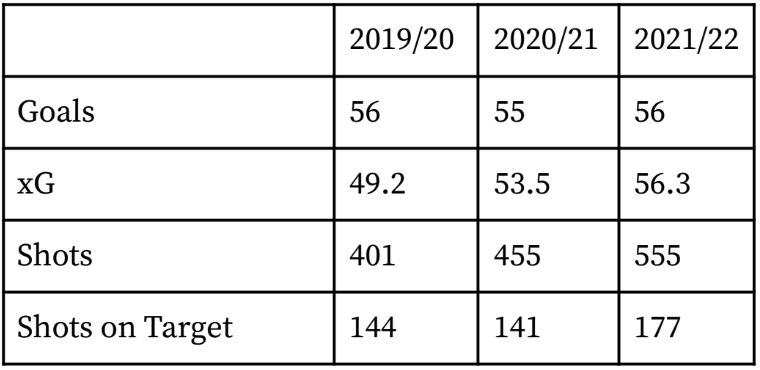
The table above shows that while Arsenal have scored a similar number of goals in the past three years, they are taking more shots and creating higher-quality chances as per their xG this season. Arteta has strengthened the foundations of their attack and made their offensive output more sustainable.
In the 2019/20 season, Arsenal were hugely reliant on Pierre-Emerick Aubameyang for their goal-scoring. He scored 22 of the club’s 56 goals despite recording an xG of just 15.8, an overperformance of 6.2 which accounted for almost all of Arsenal’s xG overperformance as a team.
Rather than being reliant upon one elite finisher who can convert chances at an unexpectedly high-rate, Arsenal are now creating better chances. Moreover, the acquisitions of Ben White and Aaron Ramsdale in the summer window drastically improved Arsenal’s ability to build out from the back.
Ramsdale is extremely comfortable bringing out the ball from goal-kicks and has an impressive passing range. White is similarly adept with his short, medium, and long-range passing as well as being composed and controlled when circulating the ball under pressure.
Along with Gabriel and Thomas Partey, the two signings provide a solid foundation for Arsenal’s build-up, allowing Arteta to push his fullbacks and midfielders higher up the pitch rather than coming deep to assist ball progression.
As a result, Arsenal are able to commit more men to attacking play and more easily create overloads to overwhelm the opposition. Granit Xhaka in particular has been reinvented from a deep-sitting progressive midfielder to a more orthodox number eight to facilitate this.
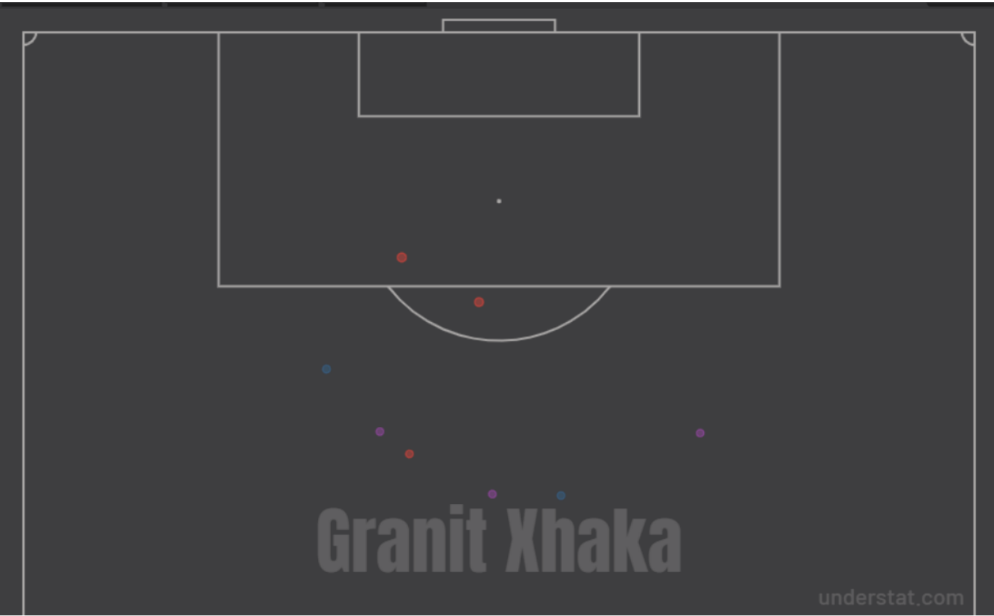

This shot maps from Understat show all of Granit Xhaka’s open-play shots in the Premier League in the 2020/21 and 2021/22 seasons respectively. It’s clear that Xhaka is taking more shots than last season and that the majority of them are being taken closer to goal.
His game is not naturally suited to this role, but by pushing Xhaka into a more advanced role, Arteta gives Arsenal another player to participate in quick one-twos and create overloads in the attacking third to help the team create more chances.
Another player whose role has changed under Arteta has been Alexandre Lacazette. While never as prolific as Aubameyang, the Frenchman was purchased and initially deployed as a traditional number nine.
Under Arteta, though, his primary task has moved from goal-scoring to dropping deep to link play and making runs to create space for Arsenal’s other attackers.
Specifically, Arsenal look to create space in the inside channels for Bukayo Saka, Martin Odegaard and one of Gabriel Martinelli or Emile-Smith Rowe to take shots. Arteta’s continued faith in these young players has not only enabled them to progress individually, but has also fostered impressive attacking chemistry between them.


As shown by the above radars, Arsenal have a fairly complete attacking lineup with any combination of Saka, Odegaard, and one of Smith-Rowe or Martinelli.
Not only are they impressive talents in isolation, but their specific strengths also complement each other well. Odegaard in particular is able to bring a level of creativity, control, and precision to Arsenal’s attack which helps unlock the dynamism and explosiveness of Martinelli, Smith Rowe, and Saka.
As their partnerships have blossomed over the course of the season, Arteta has been able to make Arsenal’s attack less-predicated on rigid, constricting passing sequences and instead given more license for his attackers to be positionally fluid and unpredictable. He’s found a more optimal balance between granting players freedom and providing them guidance with tactical instruction.
What Arsenal’s attackers lack is clinical finishing. The squad requires a higher quality forward than Lacazette to create a genuinely complete front unit.
Even though the 30-year-old is not expected to be the sole goal-threat, his 0.2 goals per 90 from 0.4 xG per 90 is simply not of the necessary quality to make Arsenal a genuine top-four side.
Arsenal need a forward who can replicate his work-rate and link-play while also posing as a more clinical finisher. Even without such a forward, though, he has already made noticeable strides in restoring the attacking identity back to Arsenal.
While their inconsistency throughout the season, slew of red cards, and disappointing finish to the campaign will undoubtedly frustrate fans, this is the consequence of entrusting a young team and young coach to lead the club.
The drawback is that when the stakes get higher and the pressure intensifies, mistakes are bound to be made as a product of inexperience. Arsenal have had a number of issues this year and will be faced with new ones in the 2022/23 season.
Arteta undoubtedly benefited from the additional time on the training ground afforded by not playing European football this year, and next season, he’ll need to become better at preparing for games with less time.
The players will also need to adapt to less recovery time and more rotation, with reinforcements being necessary to add depth to a relatively thin squad. The recruitment in the summer will need to be prudent, while previous signings will need to either maintain or improve their form.
Ramsdale in particular deserves scrutiny, as his shot-stopping has regressed as the season has continued. The best metric to evaluate goalkeepers is post-shot expected goals minus goals allowed, which compares the expected number of goals a keeper would concede based on the quality of shots they face and the number of goals they actually conceded.
A positive number indicates a keeper is performing above average and vice versa. Ramsdale’s post-shot expected goals minus goals allowed sits at a worrying -4.6. He is arguably still a net-positive to the team giving his commanding presence from set-pieces, vocal leadership, and impressive distribution.
However, for Arsenal to be regular contenders for the top four and eventually higher honors, his shot-stopping must improve. Whether Arteta can confront this and the aforementioned challenges Arsenal will face remain to be seen, and based upon the end to this season, soma fans may be skeptical.
Nevertheless, placing the future of the club in the hands of a young squad and coach is that it’s given the Gunners a new lease of life. For years, Arsenal were aimless, chasing some vaguely defined yet essentially unclear shadow of their former selves.
Now, they have a clear identity once again: defined by entrusting youth and attractive, progressive football. The players as individuals and the squad as a collective are making concrete improvements, and they will only continue to make more.
Progress is rarely linear, but with the caliber of talent Arsenal possess and their fairly stable financial resources, they are on course to make steady improvement upon their current standing.
At the head of that improvement is Arteta, the bridge between Arsenal’s glory years under Wenger and a modern vision for how to replicate such success in the future.
His appointment was the start of a long-term project and Arsenal need to be judged as such: a flawed work in progress that may yet take some years to bear fruit, but which has already shown promising glimpses of what the future may hold.
Arsenal may have missed out on Champions League football, but in keeping faith in Arteta and his players, they may come to achieve so much more.
By: Vishnu Anandraj / @vishnua711
Featured Image: @GabFoligno / Catherine Ivill / Getty Images
